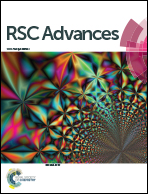An ultrasonic-assisted synthesis of leather-derived luminescent graphene quantum dots: catalytic reduction and switch on–off probe for nitro-explosives†
Abstract
The current research effort demonstrates the ultrasonic-assisted synthesis of highly fluorescent graphene quantum dots (GQDs) of ∼5 nm diameter. First, acid pyrolysis with ultrasonic hydrothermal co-cutting breaks down the coarse graphite into nanometric graphene sheets (GS) and graphene oxide sheets (GOS) with oxygen-rich functionalities. These functionalities were then used to break GOS into graphene oxide nanofibers (GONFs) and graphene oxide quantum dots (GOQDs). Finally, upon reduction, GOQDs lose oxygen linkages to produce fluorescent GQDs (quantum yield up to 27%). The as-developed GQDs were characterized with detailed optical and spectral studies through UV, PL, FTIR, TEM, AFM, XPS, XRD and other techniques. Notably, the synthesized GQDs were catalytically active to serve as a ratiometric fluorescence switch on–off probe for the reduction of toxic nitrophenols. Moreover, the GQDs detected nitrophenol derivatives at lower concentrations than previously reported analytical values. During the real sample analysis of spiked industrial water and exposed soil samples, a high selectivity and sensitivity of the applied method was achieved with a recovery of 99.7% to 101.3% at spiked concentrations of 400 nM to 100 nM, respectively. The detection limit of the photoluminescent probe for paranitrophenol was as low as 10 pM.



 Please wait while we load your content...
Please wait while we load your content...